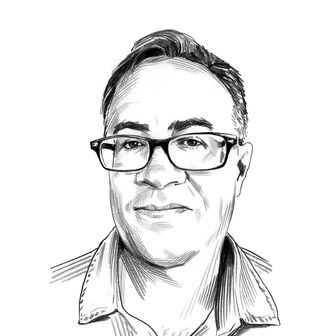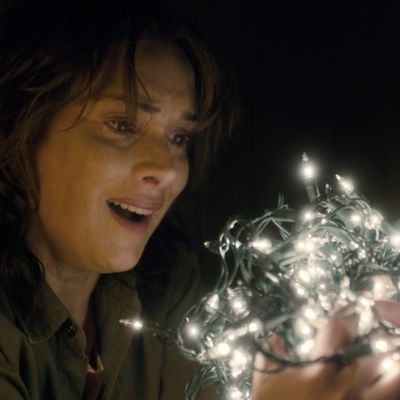
To call Stranger Things a Frankenstein’s monster of ‘80s influences wouldn’t do justice to the many parts that make up this irresistible beast. With their new Netflix series, Matt and Ross Duffer have created something more like an immense nostalgia bath, drawing on the work of Steven Spielberg, John Carpenter, Stephen King, and a host of others from a familiar era in popular culture. The glossary below identifies the myriad strands of cinematic DNA that comprise the show. Those who haven’t binge-watched it yet are duly warned: There are spoilers ahead for Stranger Things — and, of course, for a lot of classic movies.
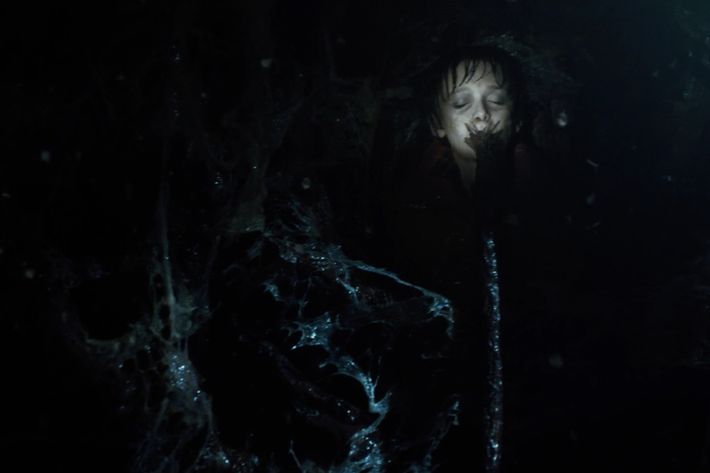
Alien (1979) and Aliens (1986)
The faceless creature in Stranger Things combines design elements and traits from Predator and the first two Alien movies. For one, there’s the sticky residue that the creature both leaves in its wake and uses to trap its victims. Whenever characters enter into the creature’s netherworld, they first have to claw their way through the goo. In episode eight, we learn it uses humans as live incubators, pinning them down and impregnating them with a snake-like analogue to Alien’s “face-huggers.” (The final scenes, which suggest a sequel of sorts, hint at a possible dinner scene like John Hurt’s in the original film.) And speaking of the face-huggers, they spring out of an egg that peels back into four corners when it opens; in Stranger Things, the creature’s face does likewise.
Altered States (1980)
Elle (Millie Bobby Brown) can only reach her full psychic potential when she’s placed in a sensory-deprivation chamber, which allows her mind to travel to another plane of reality known as “the Upside Down.” A sensory-deprivation tank also figures strongly in Ken Russell’s trippy Altered States, which puts William Hunt’s character under the influence of various psychotropic drugs.
Blowup (1966)
When shutterbug Jonathan (Charlie Heaton) surreptitiously snaps pictures of Nancy (Natalia Dyer) and her friends, he happens to take a photograph of Nancy’s friend, Barb (Shannon Purser), moments before the creature yanks her away. When Nancy gets her hands on a torn-up positive of the shot, she pieces it together and notices a mysterious, blurry figure on the extreme right end of the frame. After she brings it to Jonathan, their investigation recalls Michelangelo Antonioni’s Blowup, which is about a photographer who may or may not have captured a murder in the park. It’s a thin reference, but any movie about an ambiguous images — or sound, in the case of descendants like The Conversation and Blow Out — owes something to Blowup.
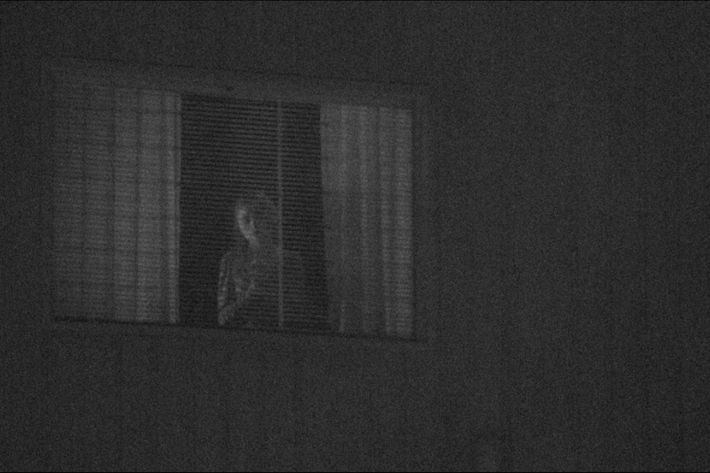
Body Double (1984)
Brian De Palma’s deliciously pervy riff on Alfred Hitchcock’s Rear Window plays with voyeurism and murder, casting Craig Wasson as a house sitter who uses a telescope to spy on a beautiful woman and witnesses a murder. In Stranger Things, Jonathan scours the woods with his camera in search of his missing brother, Will (Noah Schnapp), but pauses to catch some shots of his crush, Nancy, as she’s partying at her boyfriend’s house. The image of Jonathan peering through the blinds with telephoto lens as Nancy is about to lose her virginity recalls Body Double and its poster.
Carpenter, John (composer)
Carpenter’s work as a director casts a long shadow over Stranger Things, but his synth-based scores are also a primary influence on Kyle Dixon and Michael Stein’s music for the show. Dixon and Stein don’t create the one simple theme that animates Carpenter’s best work, like Halloween or Assault on Precinct 13, but the atmosphere is unmistakable.

Carrie (1976)
Elle is a hybrid of two Stephen King stories about girls with telekinetic power, Carrie and Firestarter. Of the two, Stranger Things owes a little more to Carrie, if only because Elle and Carrie White (Sissy Spacek) have a broader range of skills and a similarly sheltered upbringing. Though Carrie’s age feeds into a more meaningful and excruciating story of her coming-of-age as a woman, the two characters are products of needy, controlling parents — Piper Laurie’s religious zealot in Carrie; Matthew Modine’s experimental scientist in Stranger Things — who don’t allow socialization with other kids. And while Elle and Carrie are fundamentally sweet-natured, they’re capable of startling violence when provoked. (When they’re flashing trance-like stares, look out.) Stranger Things also includes a nice homage to the famous stinger that closes Carrie: Just as Carrie’s hand reaches through the soil at her gravesite — Nancy’s hand punctures through the goo when she climbs out of the Upside Down in episode six.
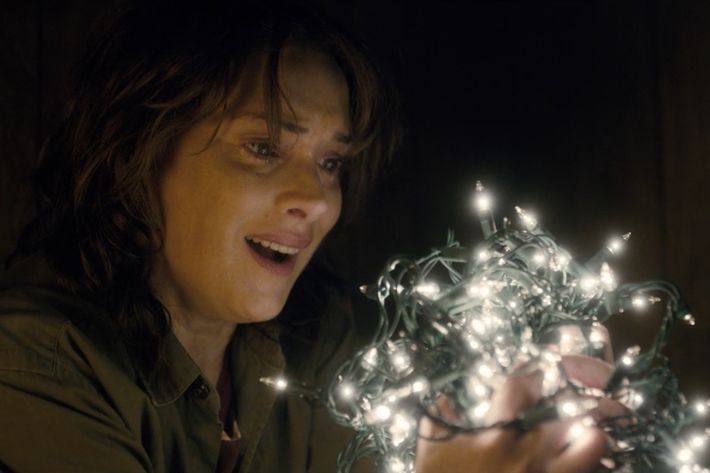
Close Encounters of the Third Kind (1977)
Stranger Things and Close Encounters both feature parents whose obsession with the supernatural looks to everyone else like madness. What’s often forgotten about Close Encounters is how much Richard Dreyfuss’s character terrorizes his family to follow an alien premonition. As he constructs Devil’s Tower out of mashed potatoes and shovels piles of dirt into his living room, his wife and children can’t get out of the house fast enough. After Joyce (Winona Ryder) realizes that her missing son is signaling her through the electrical wires in her house, she buys stacks of Christmas lights from the pharmacy, paints Ouija-like letters on the walls, and even drives an ax through the front wall in a futile attempt to reach him. Her system of communication, with its array of blinking lights, also mirrors the climax of Close Encounters.
The Empire Strikes Back (1980)
The Empire Strikes Back was released three years before Stranger Things’ story begins, so it makes sense it would be a primary obsession for adolescent boys. Mike shows Elle his Yoda toy and later reveres her for her Jedi-like powers. Dustin reaches repeatedly for the “Lando” analogy whenever he believes she’s betrayed them, but the traitorous claim never really applies.
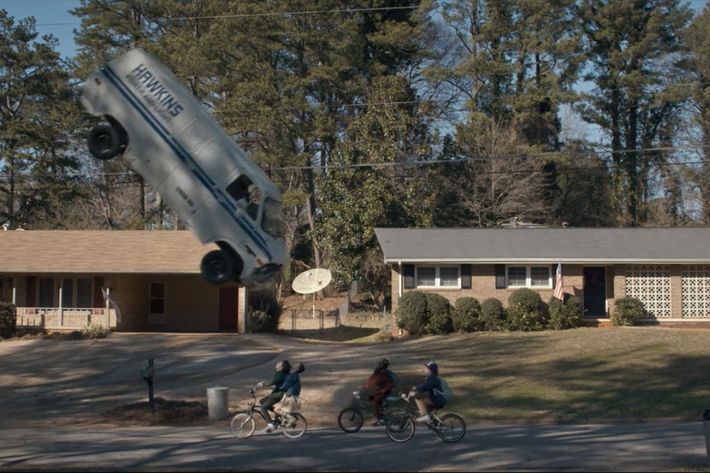
E.T.: The Extra Terrestrial (1982)
The mother lode. From its milieu and its themes to a wealth of visual references, Stranger Things owes its greatest debt to Steven Spielberg’s classic story of a lonely suburban boy who befriends an alien in need. Hawkins, Indiana, isn’t quite the California suburb of E.T., but the physical and emotional terrain is similar: a sprawling town nestled against a forest; boys dashing around in packs on their bicycles; chaotic homes where latchkey kids are free to, say, hide a supernatural being without their parents finding out. As a divorced mother barely making ends meet, Ryder channels Dee Wallace in E.T., but it’s Mike (Finn Wolfhard) and Elle that recall the Elliott-E.T. relationship most strongly. Beyond the sweetness of outcasts from different worlds forging a powerful bond, there are many specific moments when Stranger Things dips into the Spielberg well: the use of a crude communication device to reach another dimension, Elle working telekinetic magic from Mike’s bicycle, Elle wandering curiously around the house when no one’s home, government agents in Hazmat suits, and Elle dressing up in a wig. (The romantic angle of that last one, though, brings it closer to Kim Novak dressing up for Jimmy Stewart’s benefit in Vertigo.)
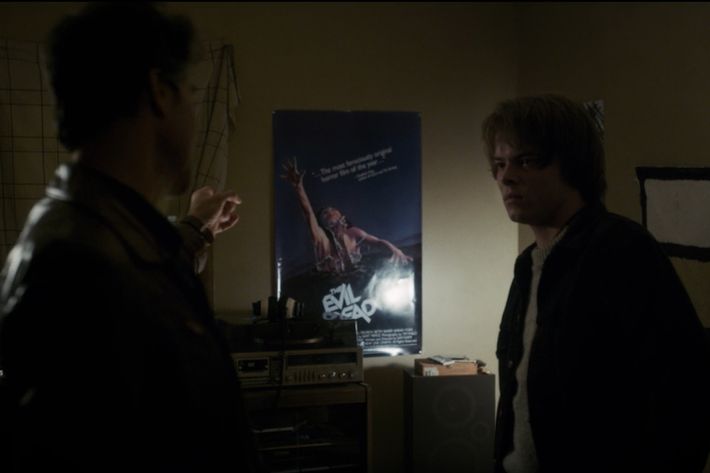
The Evil Dead (1981)
What are the chances the cult of Sam Raimi’s The Evil Dead would have reached a kid from small-town Indiana in 1983? Pretty slim, but the VHS era makes it just plausible enough that a weirdo like Jonathan would have an Evil Dead poster hanging in his room. Stranger Things doesn’t go far beyond the poster, but it does register the irony in Jonathan’s deadbeat father calling it “inappropriate” when a monster of another kind lurks behind the wall.
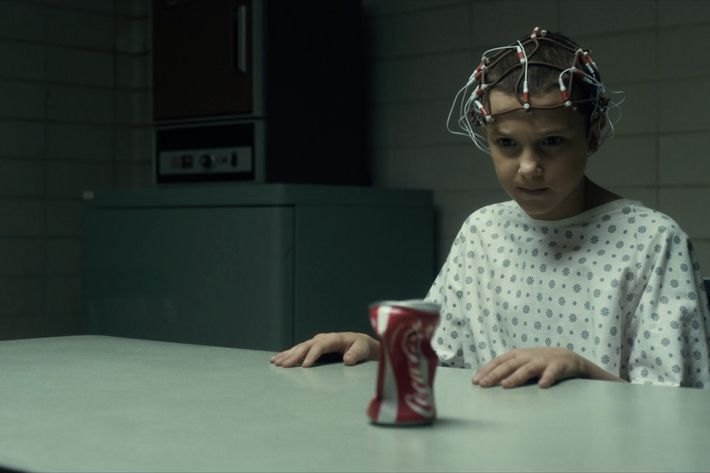
Firestarter (1984)
Take your pick between Stephen King stories of telekinesis informing Stranger Things, but a few specific ideas are owed to Firestarter rather than Carrie. For one, Elle’s age is slightly closer to Drew Barrymore’s 9-year-old pyro, and neither Stranger Things nor Firestarter could be considered a coming-of-age tale in quite the same way Carrie is. The Duffer brothers also pick up on Firestarter’s idea of associating psychic powers with nose bleeds, and they borrow the notion of experimental testing, which figures strongly into Elle’s supernatural powers. The brain sensors worn by Barrymore’s character for “the Wood Chip Test” resemble the apparatus placed on Elle’s head whenever she’s monitored in the lab.
The Fog (1980)
In John Carpenter’s The Fog, a DJ (Adrienne Barbeau) from a small town on the California coast inadvertently broadcasts a message over the airwaves from a century earlier, exposing a secret that will come back to haunt her listeners. Like the school’s ham radio in Stranger Things, the radio station acts as a medium through which another dimension can be accessed, a human signal boost for an alien transmission. The Fog and Stranger Things also share a sense of community: The citizens of a small town have to band together to stop the evil forces bearing down on them.
The Goonies (1985)
The friendship and giddy nerd-adventures of Mike, Lucas (Caleb McLaughlin), and Dustin (Gaten Matarazzo) could be considered a nod to The Goonies or Stand by Me, but the spirit of the show, as well as the period, lean more toward the former. The situation in Hawkins may be more serious — they’re looking for a missing friend, rather than lost treasure — but there’s a joyful spirit to both, as the boys improvise a mission without the intervention of adults. No doubt both groups would eagerly play Dungeons & Dragons together.
Greenberg, Richard
The Duffers cite Richard Greenberg’s iconic title designs as being an influence on the titles for Stranger Things. The cover font for Stephen King’s Needful Things immediately leaps to mind with the show’s block-lettered title, but Greenberg’s font for another King adaptation, The Dead Zone, is equally pertinent.
Jaws (1975)
Although ‘80s Spielberg is more crucial to Stranger Things, the Duffers do swipe one little detail from Jaws: The creature is a hunter that responds to blood, including blood in the water, as Barb tragically learns in episode two.
The Last Starfighter (1984)
The show has no specific references to this irresistibly tacky sci-fi film about a teenager who’s recruited into interstellar warfare, but both run on the same potent, geek-friendly idea that one day, runty kids who sit around reading comics, playing D&D, or mastering video games will be able to use that knowledge to save the universe. Because the boys in Stranger Things play D&D, for example, they’re able to make sense of the Upside Down as something akin to “the Vale of Shadows” in their role-playing game.
The Manhattan Project (1986)
No one in Hawkins can access the Department of Energy laboratory on the edge of town, and there’s no indication what’s really going on in there. In The Manhattan Project, a similar government building outside Ithaca, New York, houses what’s ostensibly a medical facility, but in fact is a lab for refining plutonium.
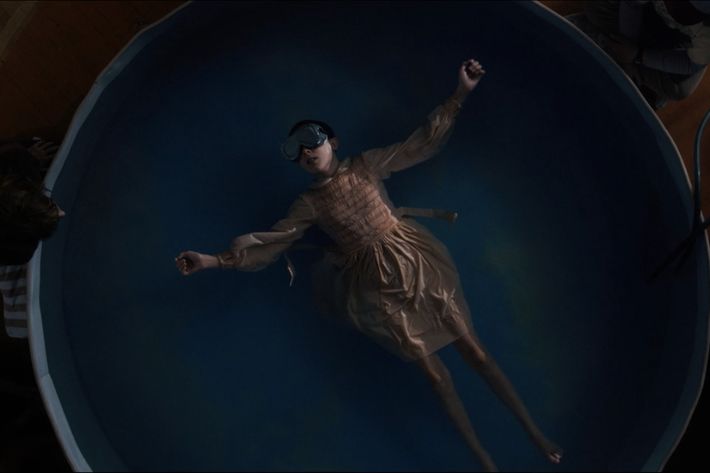
Minority Report (2002)
When Elle gets lowered into the sensory-deprivation tank at the lab, Stranger Things nods to Altered States. When our heroes improvise the same thing out of a kiddie pool and road salt, the image of her floating in supernatural reverie distinctly recalls the “pre-cogs” in Spielberg’s Minority Report, who require a special bathtub to visualize future events.
A Nightmare on Elm Street (1984)
Whenever Elle uses sensory deprivation to access the Upside Down, she’s vulnerable to the spindly-fingered creature and dependent on a trustworthy person to pull her out when things get dangerous. That, in a nutshell, is the brilliant conceit behind A Nightmare on Elm Street, in which the razor-fingered Freddy Krueger attacks teenagers in their dreams. In both Stranger Things and A Nightmare on Elm Street, devising a strategy to stop the monster involves trust, because a fully conscious person has to rescue the dreamer when they’re attacked. Dr. Brenner (Matthew Modine) proves himself untrustworthy in this respect, and he helps Elle inadvertently open the gate between the creature’s world and Hawkins. Joyce, however, proves up to the task.
O’Bannon, Dan
The name of the trooper who discovers Will’s body in the quarry is O’Bannon, a reference to Dan O’Bannon, the sci-fi wizard who scripted the original Alien and co-wrote Carpenter’s hilarious debut feature, Dark Star, when the two were students together at the University of Southern California.
Poltergeist (1982)
Step into the hall of mirrors, because Stranger Things borrows heavily from Poltergeist while taking place in a universe in which Poltergeist is explicitly referenced. In episode one, a flashback shows Joyce surprising Will with tickets to Tobe Hooper’s suburban ghost story, which thrills him because she had forbidden him from seeing it. When Will disappears, Joyce can hear her son trying to communicate from a dimension linked to the walls of her house, just like young Carol Anne in Poltergeist. For mother and son both, it has to feel like déjà vu.
Predator (1987)
The aliens in Arnold Schwarzenegger’s sci-fi/action flick are hunters with a similar gait to the creature in Stranger Things, but the true link between them is sound. A chillingly distinct clicking sound can be heard before they strike.
Scanners (1981)
Telepathic and telekinetic powers also figure into David Cronenberg’s horror movie about a conspiracy of “scanners” aiming to take over the world. Stranger Things and Cronenberg’s movie come together in a sequence where Elle thwarts a group of heavily armed government goons by squeezing their heads until blood pours from their eyes. Not quite as explosive as Scanners, but close enough.
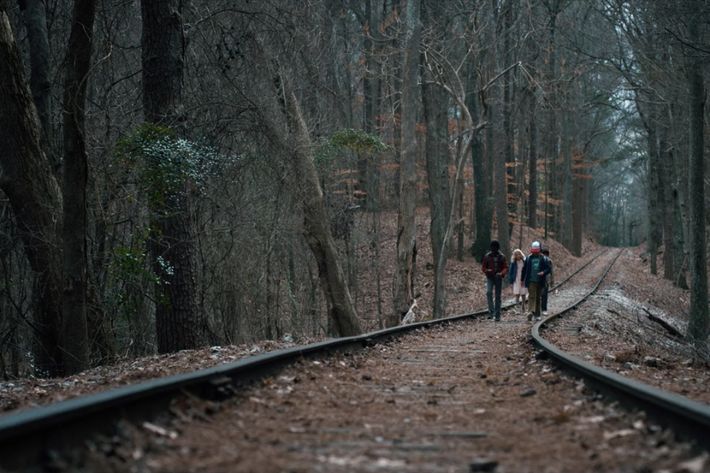
Stand by Me (1986)
When casting the four boys in Strangers Things — Mike, Lucas, Dustin, and Will — the Duffers had the actors run lines from Stand by Me, Rob Reiner’s adaptation of Stephen King’s short story “The Body.” The parallels between the two stories have more to do with tone than anything else: These boys are at a carefree age that’s suddenly troubled by real tragedy and loss, events that test and ultimately strengthen their friendship. The show also tips its hat with a walk along the train tracks in the fifth episode, when Mike, Lucas, Dustin, and Eleven are following their compasses to search for Will.
They Live (1989)
In episode six of Stranger Things, Jonathan confronts Nancy’s jealous boyfriend, Steve (Joe Keery), who they believe has been leaving slut-shaming graffiti about her all over town. The two boys have a slugfest in an alleyway, which pays homage to an absurdly protracted fight between Roddy Piper and Keith David in Carpenter’s They Live. The police break up Steve and Jonathan before it gets that ugly, but not before they both get some good licks in.
The Thing (1982)
There’s a poster for John Carpenter’s gory horror remake in the basement of Mike’s house, which means his parents must not fret as much as Joyce did about Poltergeist. The boys’ science teacher is also watching the film when Dustin calls him at 10 p.m. on a weekend, asking for detailed instructions on how to build a sensory-deprivation tank. The one major disappointment with Stranger Things is that the Duffers never try to replicate the old-school, stop-motion creature effects that set The Thing apart.
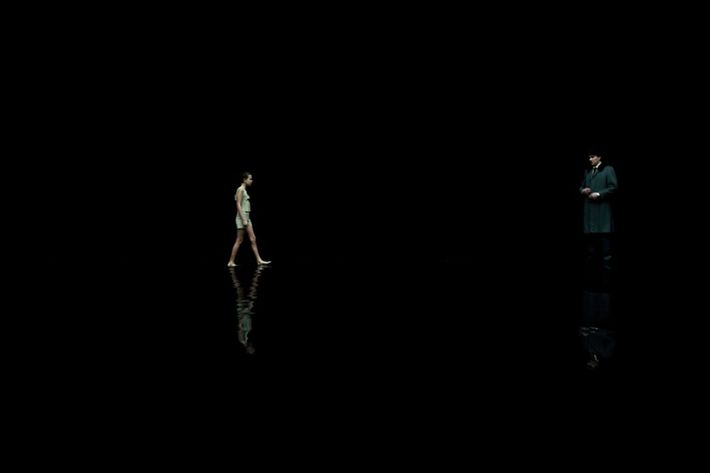
Under The Skin (2013)
In Under the Skin, Scarlett Johansson plays an alien who masquerades as a human, using her feminine wiles to lure Scottish men to their doom. Whenever she lures a man into her van, the film shifts to an abstract “black room” where the victims are consumed in a liquid darkness. Stranger Things puts Elle in a similar netherspace whenever she’s dunked into the sensory-deprivation tank. She, too, is supposed to be used as a weapon against men — in this case, Soviet targets in the Cold War — but the mission backfires.
Videodrome (1983)
David Cronenberg’s horror film about the fusion of technology and human flesh doesn’t have much in common with Stranger Things, other than the porous border between the real world and the world of fantasy. But when Will communicates with Joyce through the house in episode two, his bedroom walls distend like the skin-colored television in Videodrome. A similar effect can be seen whenever the creature tears through the seams of the Upside Down to attack.


